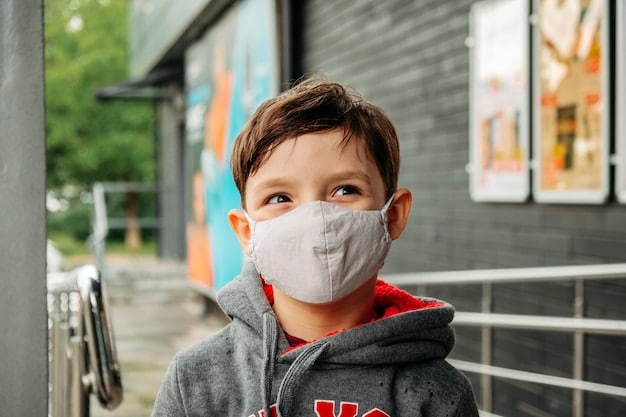Promoting Environmental Justice: Strategies for Underserved Communities

Promoting environmental justice in underserved communities involves addressing disproportionate environmental burdens through inclusive policies, community engagement, and equitable resource allocation to ensure healthier, more sustainable environments for all residents.
How can we ensure that everyone, regardless of their background or location, has access to a clean and healthy environment? Promoting environmental justice in underserved communities is not just a moral imperative, but also a crucial step towards creating a more equitable and sustainable society for all.
Understanding environmental justice
Environmental justice is the fair treatment and meaningful involvement of all people regardless of race, color, national origin, or income, with respect to the development, implementation, and enforcement of environmental laws, regulations, and policies. It seeks to address the disproportionate environmental burdens faced by underserved communities.
These communities often bear the brunt of environmental hazards, such as pollution from industrial sites, waste disposal facilities, and transportation corridors, leading to adverse health outcomes and reduced quality of life. Understanding the root causes and impacts of environmental injustice is crucial for developing effective solutions.
Disproportionate environmental burdens
Underserved communities often face a higher concentration of environmental hazards than more affluent areas. This disparity is the result of various factors, including historical zoning practices, discriminatory housing policies, and a lack of political power to influence decision-making processes.
Health impacts of environmental injustice
Exposure to environmental hazards can have severe health consequences, particularly for vulnerable populations such as children, the elderly, and individuals with pre-existing health conditions. These health impacts can range from respiratory illnesses and cardiovascular diseases to cancer and developmental disorders.

- Children’s health: Children are particularly vulnerable to the health impacts of environmental hazards due to their developing bodies and higher exposure rates.
- Respiratory illnesses: Air pollution from industrial sites and transportation corridors can exacerbate respiratory conditions such as asthma and bronchitis.
- Cancer risk: Exposure to toxic chemicals and carcinogens in contaminated soil and water can increase the risk of developing cancer.
Addressing environmental injustice requires a multi-faceted approach that combines community engagement, policy advocacy, and regulatory reform to ensure that all communities have access to a clean and healthy environment.
Community engagement and empowerment
Community engagement is essential for promoting environmental justice in underserved communities. By involving residents in decision-making processes, we can ensure that their voices are heard and their concerns are addressed. This approach fosters a sense of ownership and empowers communities to advocate for their own environmental health.
Empowering communities to take action is crucial for creating sustainable solutions that are tailored to their specific needs and circumstances. This can involve providing access to resources, training, and technical assistance to help residents become active participants in environmental decision-making.
Building trust and partnerships
Establishing trust and building strong partnerships between communities, government agencies, and other stakeholders is essential for effective community engagement. This requires open communication, transparency, and a willingness to listen to and learn from community members.
Supporting community-led initiatives
Supporting community-led initiatives is a powerful way to empower residents to take control of their environmental health. This can involve providing funding, technical assistance, and other resources to help communities develop and implement their own solutions to environmental problems.
- Community gardens: Establishing community gardens can provide access to fresh, healthy food while also creating green spaces and promoting community building.
- Citizen science projects: Engaging residents in citizen science projects can help them monitor pollution levels, identify environmental hazards, and collect data to inform policy decisions.
- Environmental education programs: Providing environmental education programs can help residents understand the environmental issues facing their communities and learn how to take action to protect their health.
When communities are empowered to participate in environmental decision-making, they are more likely to develop solutions that are effective, sustainable, and equitable.
Policy advocacy and regulatory reform
Policy advocacy and regulatory reform play a crucial role in promoting environmental justice by ensuring that environmental laws and regulations are enforced equitably. This involves advocating for policies that protect vulnerable communities from environmental hazards and holding polluters accountable for their actions.
Reforming environmental regulations is essential for addressing systemic inequalities and ensuring that all communities have access to a healthy environment. This can involve strengthening enforcement mechanisms, increasing transparency in permitting processes, and incorporating environmental justice considerations into regulatory decision-making.
Strengthening environmental regulations
Strengthening environmental regulations is a key step towards protecting vulnerable communities from environmental hazards. This can involve setting stricter emission standards, increasing monitoring and enforcement, and requiring companies to conduct environmental impact assessments before undertaking new projects.
Promoting environmental justice through legislation
Advocating for environmental justice legislation can help codify the principles of environmental justice into law and ensure that they are considered in all environmental decision-making processes. This can involve passing laws that require government agencies to address environmental inequities and provide communities with meaningful opportunities to participate in decision-making.

- Community benefits agreements: These agreements can be used to ensure that communities receive tangible benefits, such as job training, environmental remediation, and community development projects, in exchange for hosting industrial facilities.
- Cumulative impact assessments: These assessments can help identify communities that are disproportionately burdened by environmental hazards and inform decisions about where to locate new facilities.
- Public participation in permitting: Ensuring meaningful public participation in permitting processes can help communities voice their concerns and influence decisions about environmental regulations.
By advocating for strong environmental policies and regulations, we can create a more equitable and sustainable society in which all communities have access to a healthy environment.
Investing in green infrastructure
Investing in green infrastructure is a sustainable and effective way to promote environmental justice in underserved communities. Green infrastructure projects, such as urban forests, green roofs, and permeable pavements, can help reduce pollution, improve air quality, and mitigate the impacts of climate change.
These projects also provide numerous co-benefits, such as creating green spaces, promoting physical activity, and enhancing community resilience. By investing in green infrastructure, we can create healthier, more vibrant communities that are better able to withstand environmental challenges.
Benefits of green infrastructure
Green infrastructure provides a wide range of environmental, social, and economic benefits. These benefits include reducing stormwater runoff, improving air and water quality, mitigating the urban heat island effect, and creating green spaces for recreation and relaxation.
Examples of green infrastructure projects
There are many different types of green infrastructure projects that can be implemented in underserved communities. These projects can range from small-scale initiatives, such as planting trees along streets, to large-scale projects, such as creating urban parks and restoring wetlands.
- Urban forests: Planting trees in urban areas can help reduce air pollution, lower temperatures, and provide shade and habitat for wildlife.
- Green roofs: Installing green roofs on buildings can help reduce stormwater runoff, insulate buildings, and create green spaces for residents to enjoy.
- Permeable pavements: Using permeable pavements in parking lots and sidewalks can help reduce stormwater runoff and recharge groundwater supplies.
Investing in green infrastructure is a win-win strategy for promoting environmental justice and creating more sustainable communities.
Promoting clean energy and energy efficiency
Promoting clean energy and energy efficiency is essential for reducing pollution, mitigating climate change, and improving public health in underserved communities. These communities often suffer disproportionately from the health impacts of fossil fuel combustion, such as respiratory illnesses and cardiovascular diseases.
By investing in clean energy sources, such as solar and wind power, and promoting energy efficiency measures, we can reduce pollution, lower energy costs, and create new job opportunities in underserved communities.
Benefits of clean energy
Clean energy sources, such as solar and wind power, produce little to no air pollution and greenhouse gas emissions. This can help improve air quality, reduce the risk of respiratory illnesses, and mitigate the impacts of climate change.
Energy efficiency measures
Energy efficiency measures, such as weatherizing homes and installing energy-efficient appliances, can help reduce energy consumption and lower energy costs for residents. This can free up household income that can be used for other essential needs, such as food, healthcare, and education.
- Weatherization programs: These programs provide funding and technical assistance to help low-income homeowners weatherize their homes, reducing energy consumption and lowering energy costs.
- Energy-efficient appliances: Providing incentives for residents to purchase energy-efficient appliances can help reduce energy consumption and lower energy costs.
- Renewable energy incentives: Offering incentives for residents to install solar panels or other renewable energy systems can help increase the use of clean energy and reduce reliance on fossil fuels.
Promoting clean energy and energy efficiency is a powerful strategy for promoting environmental justice and creating a more sustainable energy future.
Addressing food deserts and promoting healthy food access
Addressing food deserts and promoting healthy food access is crucial for improving health outcomes and promoting environmental justice in underserved communities. These communities often lack access to fresh, healthy food, leading to poor diets and increased risk of chronic diseases, such as diabetes and heart disease.
By investing in community gardens, farmers markets, and other initiatives that increase access to healthy food, we can improve health outcomes, reduce healthcare costs, and create more vibrant and sustainable communities.
Causes of food deserts
Food deserts are often caused by a combination of factors, including poverty, lack of transportation, and the absence of grocery stores and other healthy food retailers. These factors can make it difficult for residents to access fresh, healthy food, leading to poor diets and increased risk of chronic diseases.
Strategies for addressing food deserts
There are many different strategies that can be used to address food deserts and promote healthy food access in underserved communities. These strategies can range from providing transportation assistance to attracting grocery stores and other healthy food retailers to establishing community gardens and farmers markets.
- Community gardens: Establishing community gardens can provide access to fresh, healthy food while also creating green spaces and promoting community building.
- Farmers markets: Supporting farmers markets can provide residents with access to fresh, locally grown produce and support local farmers.
- Mobile markets: Operating mobile markets can bring fresh, healthy food directly to underserved communities, making it easier for residents to access nutritious food.
Addressing food deserts and promoting healthy food access is essential for improving health outcomes and promoting environmental justice in underserved communities.
Collaboration and partnerships
Promoting environmental justice in underserved communities requires collaboration and partnerships among various stakeholders, including community residents, government agencies, non-profit organizations, and businesses. By working together, we can leverage our collective resources and expertise to address environmental inequities and create more sustainable communities.
Building strong partnerships is essential for fostering trust, sharing knowledge, and developing effective solutions that are tailored to the specific needs and circumstances of each community. This collaborative approach ensures that all stakeholders have a voice in decision-making processes and that solutions are equitable and sustainable.
Types of partnerships
Effective collaboration requires building diverse partnerships that bring together different perspectives and resources. Examples of such partnerships include:
Building effective partnerships
Building effective partnerships requires open communication, mutual respect, and a shared commitment to environmental justice. Some key steps include:
- Community-based advocacy groups and local organizations: Partnering with these organizations ensures that efforts are community-led and responsive to local needs.
- Government agencies and regulatory bodies: Collaborating with government entities helps in enforcing environmental regulations and implementing equitable policies.
- Businesses and industries: Engaging with businesses can lead to innovations in sustainable practices and investments in community health.
By fostering these types of partnerships, we can create holistic approaches to promoting environmental justice, ensuring that all voices are heard and that efforts are sustainable and equitable.
| Key Aspect | Brief Description |
|---|---|
| 🤝 Community Engagement | Involving residents in environmental decision-making. |
| 🌱 Green Infrastructure | Investing in urban forests, green roofs for pollution reduction. |
| ⚡ Clean Energy | Promoting solar and wind power to improve air quality. |
| 🍎 Healthy Food Access | Addressing food deserts with gardens and markets. |
FAQ Section
▼
Environmental justice ensures fair treatment and meaningful involvement of all people, regardless of race, income, or origin, concerning environmental laws and policies.
▼
Community engagement empowers residents to voice concerns, influence decisions, and develop tailored solutions that address their specific environmental challenges effectively.
▼
Green infrastructure, like urban forests and green roofs, reduces pollution, improves air quality, mitigates climate change, and enhances community resilience sustainably.
▼
Clean energy options, such as solar and wind power, minimize air pollution and greenhouse emissions, improve public health, and lower energy costs for communities.
▼
Addressing food deserts improves access to healthy food, reduces chronic diseases, enhances health outcomes, and fosters more sustainable communities for underserved populations.
Conclusion
Promoting environmental justice in underserved communities requires a comprehensive and collaborative approach. By prioritizing community engagement, policy advocacy, investments in green infrastructure, clean energy, and healthy food access, we can create healthier, more equitable, and sustainable communities for all.





